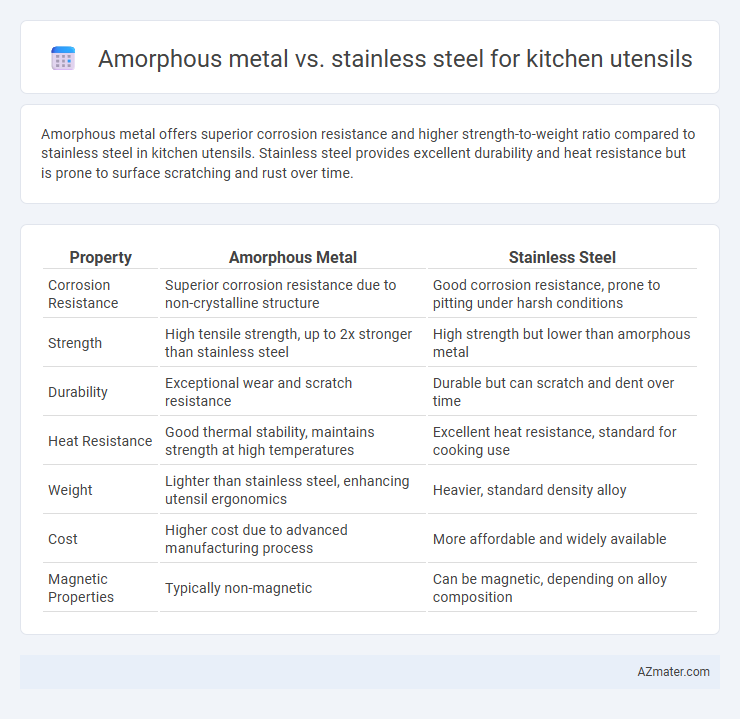Amorphous metal offers superior corrosion resistance and higher strength-to-weight ratio compared to stainless steel in kitchen utensils. Stainless steel provides excellent durability and heat resistance but is prone to surface scratching and rust over time.
Table of Comparison
| Property | Amorphous Metal | Stainless Steel |
|---|---|---|
| Corrosion Resistance | Superior corrosion resistance due to non-crystalline structure | Good corrosion resistance, prone to pitting under harsh conditions |
| Strength | High tensile strength, up to 2x stronger than stainless steel | High strength but lower than amorphous metal |
| Durability | Exceptional wear and scratch resistance | Durable but can scratch and dent over time |
| Heat Resistance | Good thermal stability, maintains strength at high temperatures | Excellent heat resistance, standard for cooking use |
| Weight | Lighter than stainless steel, enhancing utensil ergonomics | Heavier, standard density alloy |
| Cost | Higher cost due to advanced manufacturing process | More affordable and widely available |
| Magnetic Properties | Typically non-magnetic | Can be magnetic, depending on alloy composition |
Introduction to Amorphous Metal and Stainless Steel
Amorphous metal, also known as metallic glass, is characterized by its non-crystalline atomic structure, offering exceptional strength, corrosion resistance, and wear resistance compared to traditional metals. Stainless steel, an alloy primarily composed of iron, chromium, and nickel, is well-known for its durability, corrosion resistance, and ease of maintenance, making it a common choice for kitchen utensils. While stainless steel exhibits a crystalline structure, amorphous metals provide unique mechanical properties such as higher hardness and elasticity, influencing their performance in culinary tools.
Composition and Structure Comparison
Amorphous metals, also known as metallic glasses, feature a disordered atomic structure without grain boundaries, differing significantly from the crystalline lattice of stainless steel composed primarily of iron, chromium, and nickel. This non-crystalline structure in amorphous metals provides superior strength and corrosion resistance compared to the multi-phase microstructure of stainless steel, which includes varying carbide precipitates. Stainless steel's composition with 10-30% chromium forms a passive oxide layer enhancing durability, while amorphous metals rely on their uniform atomic arrangement to resist chemical attack and wear in kitchen utensil applications.
Strength and Durability Differences
Amorphous metals, characterized by their non-crystalline atomic structure, exhibit higher strength and superior resistance to wear and corrosion compared to traditional stainless steel, making them highly durable for kitchen utensils. Stainless steel, especially grades like 18/8 (304), offers excellent corrosion resistance and moderate strength but can be prone to scratching and deformation under heavy use. The unique properties of amorphous metals enable kitchen utensils to maintain sharp edges and structural integrity longer than stainless steel counterparts under rigorous cooking conditions.
Corrosion Resistance in Kitchen Environments
Amorphous metals exhibit superior corrosion resistance compared to stainless steel in kitchen environments due to their non-crystalline atomic structure, which eliminates grain boundaries that typically act as corrosion initiation sites. This unique structure enhances their ability to withstand exposure to acidic and alkaline substances commonly found in food preparation. Stainless steel, while corrosion-resistant, can still suffer from pitting and crevice corrosion in aggressive kitchen conditions, making amorphous metals a more durable option for long-lasting kitchen utensils.
Weight and Handling in Utensil Design
Amorphous metal offers significantly lighter weight compared to stainless steel, enhancing ease of handling and reducing user fatigue in kitchen utensils. Its non-crystalline structure provides superior strength-to-weight ratio, allowing for thinner, more ergonomic utensil designs without sacrificing durability. Stainless steel, while heavier, delivers excellent corrosion resistance and traditional robustness but may compromise comfort during prolonged use due to increased weight.
Heat Resistance and Thermal Conductivity
Amorphous metals exhibit superior heat resistance compared to stainless steel, withstanding higher temperatures without deformation due to their non-crystalline atomic structure. Their lower thermal conductivity also means they retain heat longer, enhancing cooking control and energy efficiency in kitchen utensils. Stainless steel, while durable and corrosion-resistant, transfers heat more rapidly, which can lead to uneven cooking and higher energy consumption.
Maintenance and Cleaning Requirements
Amorphous metals used in kitchen utensils offer superior corrosion resistance and do not develop rust or pitting over time, reducing the need for frequent deep cleaning compared to stainless steel. Stainless steel utensils require regular polishing to maintain their shine and are prone to staining and surface scratches that can harbor bacteria, increasing maintenance efforts. The non-crystalline structure of amorphous metal provides a smoother surface that resists food adhesion, making cleaning faster and more efficient than traditional stainless steel cookware.
Cost and Availability for Kitchen Products
Amorphous metal kitchen utensils typically have higher production costs due to complex manufacturing processes and limited raw material availability, making them less common in the market. Stainless steel offers a more affordable and widely available option, benefiting from established supply chains and mass production techniques. The cost-efficiency and accessibility of stainless steel make it the preferred choice for most kitchen products.
Environmental Impact and Sustainability
Amorphous metal cookware generates less environmental waste due to its superior durability and corrosion resistance, reducing replacement frequency compared to stainless steel. Stainless steel, while recyclable, requires high-energy production processes that contribute significantly to carbon emissions. Choosing amorphous metal supports sustainability by minimizing resource consumption and enhancing product lifespan in kitchen utensils.
Final Recommendation: Best Choice for Kitchen Utensils
Amorphous metal offers superior corrosion resistance, exceptional strength, and a smoother surface compared to stainless steel, making it highly durable and easy to clean for kitchen utensils. Stainless steel remains widely available and cost-effective, with proven performance in heat resistance and rust prevention, making it a reliable choice for everyday use. For those prioritizing advanced durability and hygiene, amorphous metal is the best choice, whereas stainless steel suits budget-conscious consumers seeking proven functionality.

Infographic: Amorphous metal vs Stainless steel for Kitchen utensil
 azmater.com
azmater.com